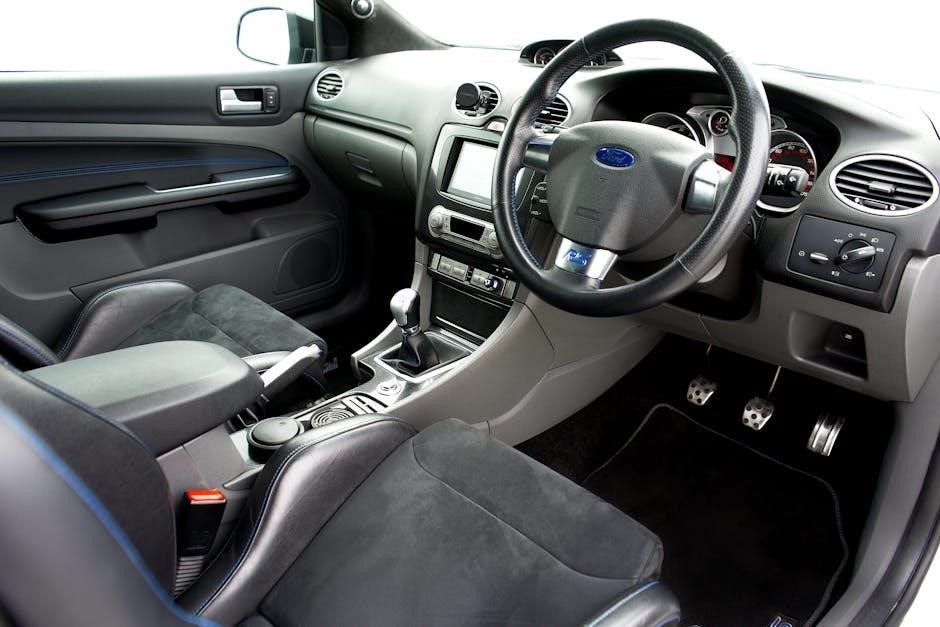2014 ford focus user manual
The 2014 Ford Focus User Manual serves as a comprehensive guide for owners to understand and operate their vehicle effectively. It covers essential information on features, maintenance, and safety, ensuring optimal performance and longevity of the car. Available in PDF format, it provides easy access to detailed instructions and recommendations for drivers.
1.1 Purpose of the Manual
The primary purpose of the 2014 Ford Focus User Manual is to provide owners with a detailed understanding of their vehicle’s features, operation, and maintenance requirements. This manual ensures drivers can utilize their car safely and efficiently, maximizing performance and longevity. It covers essential topics such as instrument cluster operation, safety features, and maintenance schedules. Additionally, it includes guidelines for troubleshooting common issues and interpreting diagnostic codes. The manual is designed to be user-friendly, offering clear instructions for both novice and experienced drivers. By following the recommendations outlined, owners can maintain their vehicle in optimal condition and address potential problems promptly. This resource is indispensable for anyone seeking to fully understand and care for their 2014 Ford Focus.
1.2 Structure and Organization
The 2014 Ford Focus User Manual is structured to ensure easy navigation and accessibility of information. It is divided into clear sections, each focusing on specific aspects of the vehicle. The manual begins with an introduction, followed by detailed sections on the instrument cluster, safety features, vehicle operation, maintenance, and additional features. Each section is further subdivided into subheadings, making it simple for users to locate relevant information quickly. The use of headings, subheadings, and bullet points enhances readability and organization. Additionally, the manual includes quick reference guides and an index to help drivers find specific topics without browsing through the entire document. This logical structure ensures that users can efficiently access the information they need, whether they are familiar with the vehicle or exploring its features for the first time. The clear organization makes the manual a valuable resource for both routine operations and troubleshooting.
1.3 Important Symbols and Warnings
The 2014 Ford Focus User Manual includes a variety of symbols and warnings to ensure safe and proper use of the vehicle. These symbols are designed to alert drivers to potential risks, maintenance needs, or operational guidelines. Located throughout the manual, they are accompanied by clear explanations to help users understand their meaning and importance. For example, warning symbols may indicate issues like low oil levels, high engine temperature, or malfunctioning safety systems. The manual also highlights critical precautions, such as proper seat belt usage and airbag warnings, to prevent accidents and injuries. By paying attention to these symbols and warnings, drivers can avoid potential hazards and ensure their vehicle operates optimally. The manual emphasizes the importance of adhering to these guidelines to maintain safety and extend the lifespan of the car. Ignoring these warnings could lead to serious consequences, including engine damage or personal harm. Always refer to the manual for clarification if a symbol appears unfamiliar.

Instrument Cluster and Dashboard Overview
The 2014 Ford Focus dashboard features a well-organized instrument cluster, including speedometer, tachometer, and warning lights. It provides essential vehicle information at a glance, ensuring driver awareness and safety.
2.1 Dashboard Layout and Components
The dashboard of the 2014 Ford Focus is designed for intuitive control and easy access to essential functions. It features a central instrument cluster with a speedometer, tachometer, and fuel gauge. The steering wheel includes controls for audio, cruise control, and Bluetooth connectivity. The center console houses the SYNC infotainment system, climate controls, and USB ports. Warning lights and indicators are strategically placed to alert the driver of system statuses or potential issues. The layout prioritizes ergonomics, ensuring all components are within easy reach. This design enhances driver comfort and focus on the road. The dashboard also includes vents for heating and cooling, a glove compartment, and a passenger-side airbag status indicator. Overall, the dashboard is user-friendly, combining functionality and modern styling to provide a seamless driving experience.
2.2 Understanding Warning Lights and Indicators
The 2014 Ford Focus features a range of warning lights and indicators on its instrument cluster to alert the driver of various vehicle statuses or potential issues. These lights include the Check Engine Light, which illuminates when the vehicle’s onboard diagnostics detect a problem. The Anti-lock Braking System (ABS) light indicates a malfunction in the braking system. The Tire Pressure Monitoring System (TPMS) light warns of low tire pressure, prompting the driver to check and adjust tire inflation levels. Other indicators include the oil pressure light, battery charge warning, and seatbelt reminders. Each light corresponds to specific system checks, ensuring timely attention to maintenance or repairs. Understanding these indicators is crucial for maintaining vehicle health and ensuring safety on the road. The manual provides detailed explanations of each light, helping drivers interpret and respond appropriately to warnings. This feature enhances overall driving safety and vehicle longevity. Regular monitoring of these indicators is highly recommended.
2.3 Odometer and Trip Computer
The 2014 Ford Focus features an odometer that displays the total mileage of the vehicle, providing a clear record of distance traveled. Additionally, the trip computer offers functionality to track individual trips, with two separate tripmeters available for monitoring. These tools allow drivers to measure distance, fuel efficiency, and other metrics, enhancing journey planning and vehicle monitoring. The odometer and trip computer are accessed via the instrument cluster, with controls on the steering wheel enabling easy navigation between views. For models equipped with a digital display, the trip computer also shows real-time data such as average speed and remaining distance based on fuel level. The manual provides detailed instructions on how to reset tripmeters and interpret the displayed information. This feature is designed to optimize driving efficiency and maintain accurate records of vehicle usage. Proper use of these functions ensures a more informed and enjoyable driving experience.

Safety Features and Precautions
The 2014 Ford Focus User Manual highlights essential safety features, including airbags, seat belts, and child locks, to ensure driver and passenger protection. It also outlines precautions for safe vehicle operation and maintenance.
3.1 Airbags and Passive Safety Systems
The 2014 Ford Focus is equipped with a comprehensive suite of airbags and passive safety systems designed to protect occupants in the event of a collision. These include front airbags for the driver and passenger, side airbags, and curtain airbags for enhanced protection. The manual emphasizes the importance of these systems, explaining how they work in conjunction with seat belts to minimize injury. It also provides detailed information on the locations of airbags and how they deploy during different types of impacts. Additionally, the manual highlights the supplementary restraint system, which automatically activates airbags and tightens seat belts during severe collisions. The guide also includes warnings about the potential risks of airbag deployment, such as injury from the force of the bag inflating. Proper usage of these systems is stressed to ensure maximum safety. This section is crucial for understanding how the vehicle’s passive safety features contribute to overall occupant protection.
3.2 Seat Belts and Restraint Systems
The 2014 Ford Focus User Manual places a strong emphasis on the proper use of seat belts and restraint systems as the primary means of occupant protection. It explains that all seats are equipped with three-point seat belts, designed to securely restrain passengers during sudden stops or collisions. The manual details how to correctly fasten and adjust seat belts, ensuring they are snug and properly positioned across the chest and hips. It also highlights the importance of rear seat belts, often overlooked but equally critical for passenger safety. Additionally, the guide discusses special considerations, such as seat belt usage during pregnancy or for children, to ensure safe and effective restraint. The manual further emphasizes the role of seat belt pre-tensioners and load limiters, which automatically tighten the belt during a collision to reduce injury risk. It strongly advises against modifying or tampering with the seat belt system, as this could compromise its effectiveness. Adhering to these guidelines is essential for maximizing occupant protection in all driving conditions.
3.3 Child Safety Locks and Rear Door Protection
The 2014 Ford Focus User Manual highlights the importance of child safety locks and rear door protection features to ensure the well-being of young passengers. These locks are designed to prevent rear doors from being opened accidentally by children. The manual explains how to activate and deactivate the child safety locks, typically located on the rear doors. It also emphasizes the need to test the locks after activation to ensure proper function. Additionally, the manual provides guidance on using rear door child protection systems, which can be engaged to prevent unauthorized opening of the doors. These features are crucial for safeguarding children while traveling. The guide also reminds users to familiarize themselves with these systems to avoid unintended door openings. By following the manual’s instructions, parents and caregivers can create a safer environment for children in the vehicle. Regular checks of these systems are recommended to maintain their effectiveness. Always refer to the manual for detailed diagrams and step-by-step instructions.

Operating the Vehicle
The 2014 Ford Focus User Manual provides detailed instructions for operating the vehicle safely and efficiently. It covers essential driving practices, basic vehicle controls, and adjusting settings for optimal comfort and performance.
4.1 Starting and Stopping the Engine
Starting and stopping the engine of your 2014 Ford Focus is a straightforward process. To start the engine, insert the key into the ignition, turn it to the “start” position, and press the ignition button. Ensure the parking brake is engaged and the transmission is in park or neutral. For models equipped with a keyless system, press the start/stop button while depressing the brake pedal. When stopping the engine, ensure the vehicle is stationary, shift into park, and turn off all unnecessary accessories to avoid battery drain. Always refer to the user manual for specific instructions tailored to your vehicle’s configuration. Proper engine management helps maintain efficiency and longevity, ensuring your Ford Focus performs optimally for years to come.
4.2 Transmission Types and Operation

The 2014 Ford Focus offers two primary transmission types: a six-speed manual and a six-speed automatic. The manual transmission provides precise control, with a smooth clutch and gearshift, ideal for drivers who prefer an engaging driving experience. The automatic transmission, on the other hand, offers convenience and ease, especially in heavy traffic or urban driving. Both systems are designed for optimal fuel efficiency and performance. To operate the manual transmission, depress the clutch pedal fully before shifting gears, ensuring smooth transitions. For the automatic, simply move the gear selector through the available modes (P, R, N, D, L). The manual mode on the automatic allows for driver-controlled gear shifts using the steering wheel-mounted paddles. Always ensure the vehicle is stationary before shifting into reverse or drive. Proper operation of the transmission ensures smooth acceleration, reduced wear, and enhanced driving comfort.
4.3 Fuel Requirements and Recommendations
The 2014 Ford Focus is designed to operate on high-quality, unleaded gasoline to ensure optimal performance and fuel efficiency. The recommended fuel is regular unleaded gasoline with an octane rating of 87. However, for improved engine performance, mid-grade or premium unleaded gasoline with an octane rating of 91 or higher can be used, though it is not required. Using lower-quality or incorrect fuel may result in reduced fuel efficiency or potential engine damage. The fuel tank capacity is approximately 12 gallons, and it is important to avoid overfilling to prevent spillage and potential damage to the fuel system. For vehicles equipped with the EcoBoost engine, premium fuel is recommended to maximize performance and efficiency. Always refer to the fuel doorjamb or owner’s manual for specific recommendations. Proper fueling practices help maintain the vehicle’s longevity and ensure compliance with emissions standards. Regularly checking and maintaining the fuel system is also essential for optimal vehicle operation.

Maintenance and Service Schedule
Regular maintenance is crucial for extending the life and performance of your 2014 Ford Focus. The recommended service schedule includes oil changes every 5,000 to 7,500 miles, tire rotations, and inspections. Follow the guidelines in your owner’s manual for specific intervals and procedures to ensure optimal vehicle health and prevent premature wear. Adhering to the schedule helps maintain warranty coverage and ensures safety on the road. Always use genuine or approved parts for repairs and replacements to uphold your vehicle’s quality and performance standards. Proper maintenance not only enhances fuel efficiency but also reduces long-term repair costs. Refer to the manual for detailed instructions tailored to your vehicle’s needs and specifications.
5.1 Recommended Maintenance Intervals
The 2014 Ford Focus requires regular maintenance to ensure optimal performance and longevity. The recommended maintenance intervals are designed to address specific components at designated mileage or time intervals. Oil changes are typically recommended every 5,000 to 7,500 miles, depending on driving conditions. Tire rotations should be performed every 6,000 to 8,000 miles to ensure even tread wear. Brake pads should be inspected every 12,000 miles, and the battery should be checked every 6 months or 6,000 miles. The air filter should be replaced every 15,000 miles, while the spark plugs are due for replacement at 60,000 miles. Timing belts and drive belts should be inspected at 60,000 miles and replaced as needed. Regular inspections of fluids, hoses, and belts are also crucial. Adhering to these intervals ensures your vehicle runs efficiently, prevents costly repairs, and maintains its warranty. Always consult your owner’s manual for specific guidelines tailored to your driving habits and conditions.

5.2 Oil Change and Fluid Check Guidelines
The 2014 Ford Focus requires regular oil changes to maintain engine health and performance. Use synthetic oil for better fuel efficiency and engine protection, especially in extreme temperatures. The recommended oil capacity is 4.5 to 5 quarts, depending on the engine type. Change the oil every 5,000 to 7,500 miles, or as specified in the manual. Always replace the oil filter with a Ford-approved filter to ensure proper filtration. When checking fluids, locate the coolant reservoir, transmission fluid dipstick, brake fluid reservoir, and windshield washer reservoir under the hood. Ensure all fluid levels are within the recommended range. For coolant, check the level when the engine is cold, and top up with a 50/50 mix of coolant and water if necessary. Transmission fluid should be checked while the engine is running and warm. Always refer to the manual for specific fluid specifications to avoid damage. Regular fluid checks help prevent overheating, corrosion, and system failures, ensuring your vehicle runs smoothly and efficiently.
5.3 Tire Pressure Monitoring and Rotation
The 2014 Ford Focus is equipped with a Tire Pressure Monitoring System (TPMS) that alerts drivers if tire pressure falls below the recommended level. Check tire pressure monthly and before long trips, using the pressures listed on the tire information placard on the driver’s doorjamb or inside the fuel filler door. Recommended pressures typically range from 35 to 40 PSI, depending on tire size and load. Rotate tires every 5,000 to 7,500 miles to ensure even tread wear and extend tire life. Use the standard rearward cross rotation pattern for most models. After rotating tires or changing a spare, reset the TPMS using the procedure outlined in the manual. Proper tire maintenance improves fuel efficiency, handling, and safety. Always refer to the manual for specific guidelines tailored to your vehicle’s configuration and engine type. Regular checks and rotations help prevent uneven wear and potential tire failure.
5.4 Battery Care and Replacement
Proper care and maintenance of the battery in your 2014 Ford Focus are crucial for reliable starting power and overall vehicle performance. Regularly inspect the battery terminals to ensure they are clean, secure, and free from corrosion. Use a wire brush to clean terminals if necessary. Check the battery charge level periodically, especially in extreme temperatures, and recharge it if needed. The battery is maintenance-free, so there’s no need to add water. Look for signs of wear, such as swelling, cracks, or dim lights, which indicate the battery may need replacement. When replacing the battery, always disconnect the negative terminal first to prevent electrical shocks or damage. Refer to the manual for torque specifications when tightening terminals. Use a replacement battery that meets Ford’s specifications. For disposal, take the old battery to an authorized service center or recycling facility to ensure environmentally responsible handling. Follow these guidelines to maintain your vehicle’s electrical system and prevent unexpected breakdowns.

Additional Features and Accessories

The 2014 Ford Focus offers a range of additional features and accessories designed to enhance your driving experience. These include advanced infotainment systems, Bluetooth connectivity for hands-free calls, and optional driver-assist technologies like cruise control. Customize your vehicle with genuine Ford accessories to ensure optimal performance and style, all while maintaining compatibility and safety standards.
6.1 Infotainment System and Navigation
The 2014 Ford Focus features an advanced infotainment system designed to enhance your driving experience. This system includes a high-resolution touchscreen display, voice command functionality, and seamless integration with Bluetooth-enabled devices for hands-free calls and music streaming. The navigation system provides turn-by-turn directions, real-time traffic updates, and points of interest, ensuring you stay on course. Additional features like USB connectivity and auxiliary input allow you to connect external devices, while the premium audio system delivers high-quality sound. For added convenience, the system supports SYNC technology, enabling voice-activated control of phone, media, and navigation functions. Customize your experience by adjusting settings, such as display brightness and audio equalization, to suit your preferences. Refer to the manual for detailed instructions on pairing devices, updating software, and troubleshooting common issues.
6.2 Bluetooth and Hands-Free Phone Operation
The 2014 Ford Focus offers a Bluetooth-enabled infotainment system, allowing drivers to pair their mobile devices for hands-free phone operation. This feature enhances safety by minimizing distractions while driving. To pair a device, ensure Bluetooth is enabled on your phone and select the vehicle’s system from the available devices list. Once connected, you can make and receive calls, access your phonebook, and stream audio content wirelessly. The system supports voice commands, enabling you to dial contacts or accept calls without taking your hands off the wheel. For troubleshooting, refer to the manual for guidance on resetting connections or resolving pairing issues. This feature is compatible with most smartphones and ensures a seamless integration of your mobile device with the vehicle’s technology, providing convenience and improved road safety. Always follow the manual’s instructions for optimal performance and functionality.
6.3 Cruise Control and Driver Assist Features
- Cruise Control: The 2014 Ford Focus features a standard cruise control system, allowing drivers to maintain a set speed for comfort during long drives. To activate, press the cruise control button on the steering wheel, set the desired speed using the +/- buttons, and the vehicle will automatically adjust to maintain that speed.
- Adaptive Cruise Control (Optional): Available on higher trims, this advanced system adjusts your speed to maintain a safe distance from the vehicle ahead, enhancing highway driving convenience. It automatically slows down or accelerates based on traffic conditions.
- Lane-Keeping Assist: This feature gently steers the vehicle back into its lane if it drifts without signaling, reducing driver fatigue on long trips. It operates at speeds above 40 mph and can be adjusted or deactivated if needed.
- Traffic Sign Recognition (Optional): Higher trims include a camera-based system that detects and displays speed limit signs on the instrument cluster, helping drivers stay aware of road regulations.
These features work together to enhance safety, convenience, and driving comfort, making the 2014 Ford Focus a technologically advanced vehicle for its class.

Troubleshooting and Diagnostics
This section helps identify common issues and solutions for the 2014 Ford Focus. It includes diagnostic trouble codes (DTCs) and guides for resolving problems using the vehicle’s onboard diagnostics system effectively.
7.1 Common Issues and Solutions
The 2014 Ford Focus User Manual addresses various common issues that owners may encounter. One prevalent problem is the illumination of dashboard warning lights, which can indicate issues ranging from loose gas caps to serious engine problems. Another common issue is transmission hesitation or rough shifting, often resolved by updating the transmission control module software. Some owners have reported issues with the SYNC infotainment system freezing or failing to connect to Bluetooth devices, which can typically be fixed by resetting the system or updating its software. Additionally, occasional problems with the rear door locks engaging unintentionally have been noted, and this can usually be corrected by adjusting the child safety lock settings. The manual provides step-by-step solutions for these and other common issues, helping owners troubleshoot and resolve problems efficiently without requiring immediate professional assistance. Regular maintenance, as outlined in the manual, can also prevent many of these issues from arising.
7.2 Diagnostic Trouble Codes (DTCs)
The 2014 Ford Focus User Manual includes a section on Diagnostic Trouble Codes (DTCs), which are essential for identifying and resolving vehicle issues. These codes, generated by the car’s onboard diagnostics system, indicate specific problems within the engine, transmission, emissions, or other systems. Common DTCs for the 2014 Ford Focus include P0171 (System Too Lean), P0300 (Random/Multiple Cylinder Misfire), and P0401 (Exhaust Gas Recirculation Flow Insufficient). The manual provides a detailed list of these codes, their meanings, and potential causes. It also guides owners on how to use an OBD-II scanner to retrieve and interpret DTCs. By addressing these codes promptly, drivers can prevent minor issues from escalating into major repairs. The manual emphasizes the importance of referring to a qualified technician if the problem persists after attempting suggested fixes. This section is invaluable for DIY troubleshooting and ensures owners are well-informed about their vehicle’s health. Always consult the manual or a professional for accurate diagnostics and solutions.

